
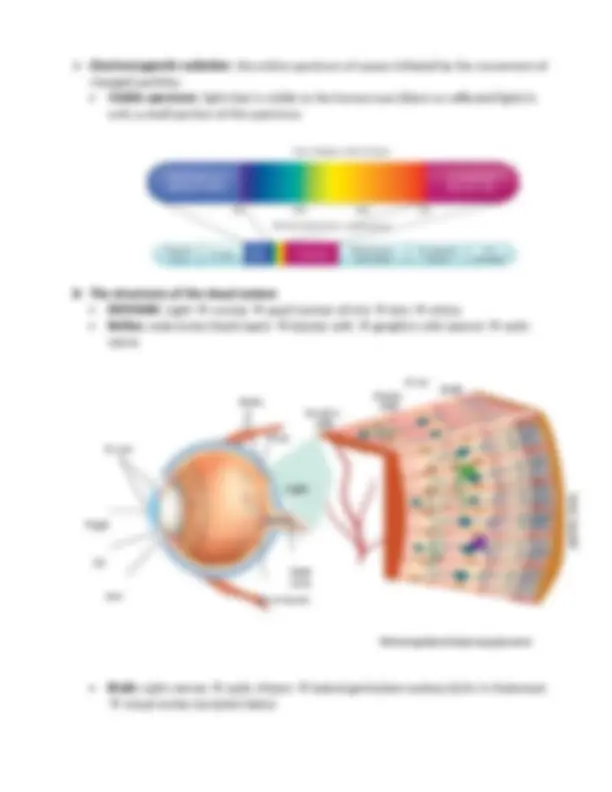
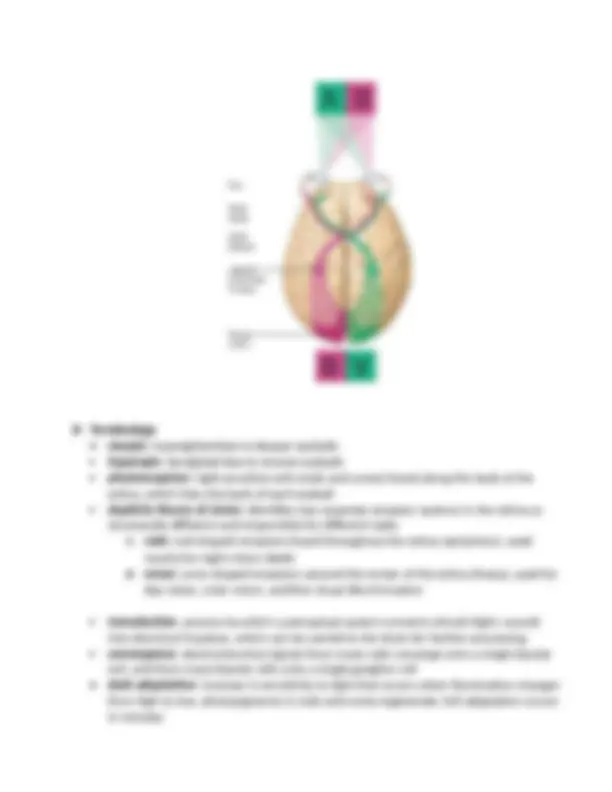
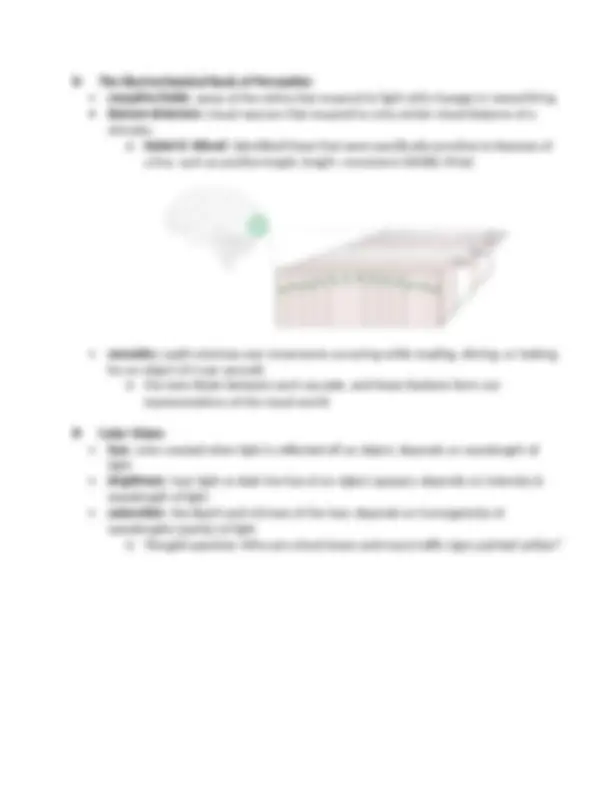
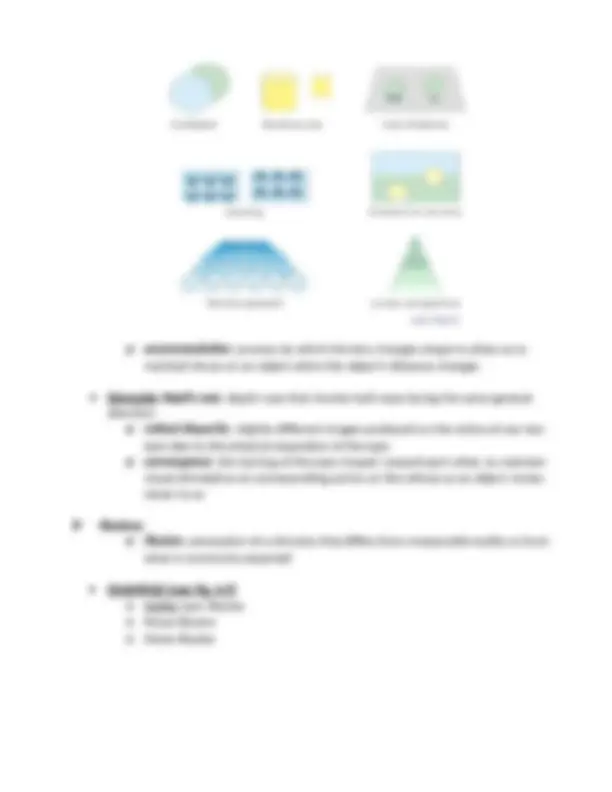
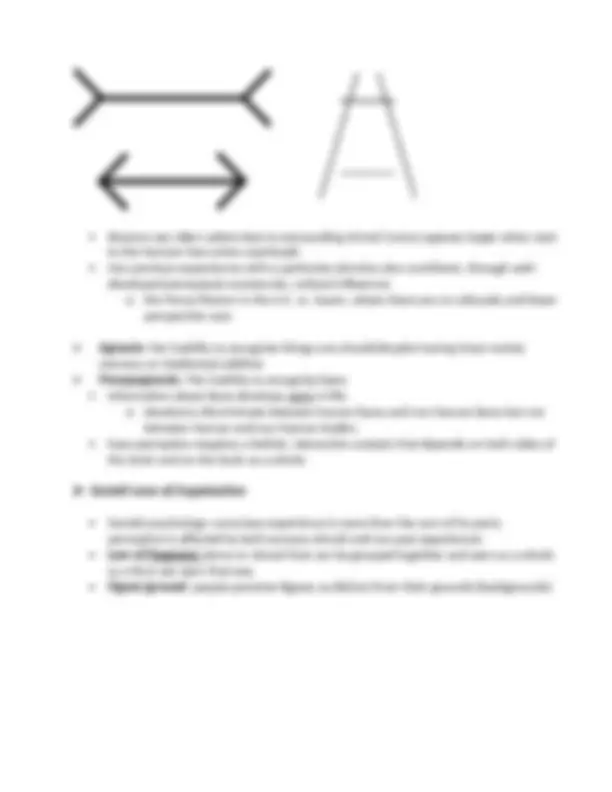
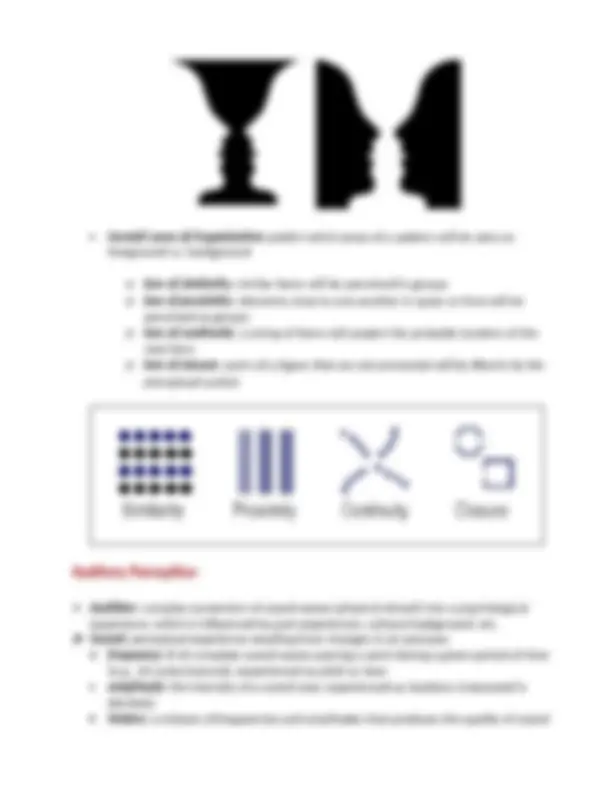
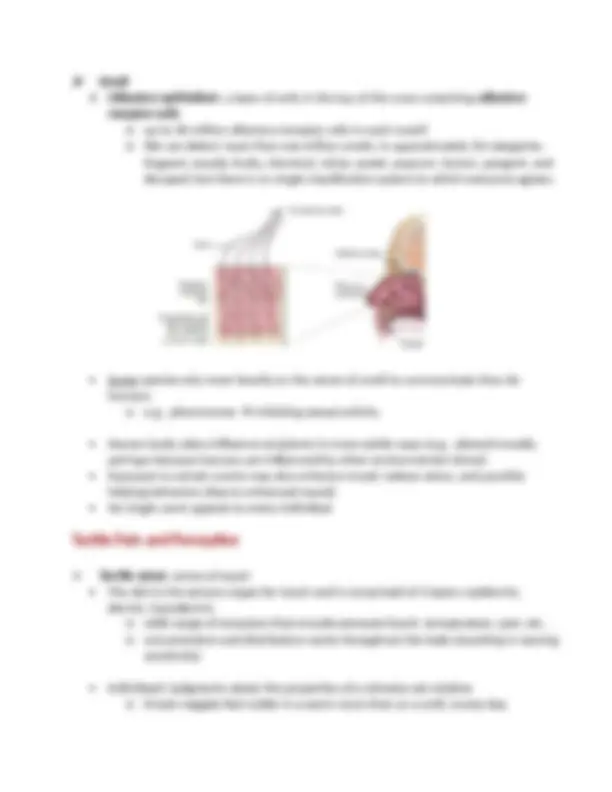
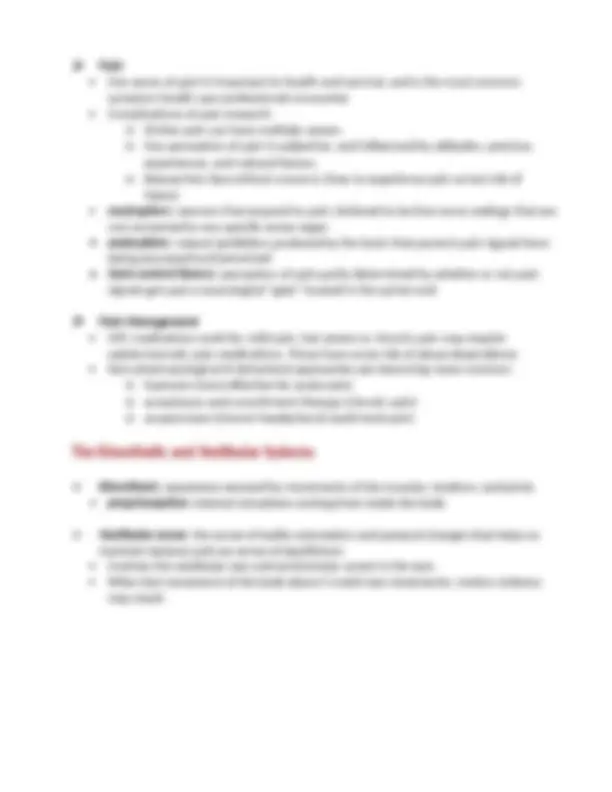


Study with the several resources on Docsity

Earn points by helping other students or get them with a premium plan


Prepare for your exams
Study with the several resources on Docsity

Earn points to download
Earn points by helping other students or get them with a premium plan
Community
Ask the community for help and clear up your study doubts
Discover the best universities in your country according to Docsity users
Free resources
Download our free guides on studying techniques, anxiety management strategies, and thesis advice from Docsity tutors
This document delves into the fascinating field of psychophysics, exploring the relationship between physical stimuli and human perception. It covers various aspects such as psychophysics processes, absolute and difference thresholds, subliminal perception, visual perception, electromagnetic radiation, and the electrochemical basis of perception. The document also discusses audition, sound localization, hearing impairments, gustation, and olfactory perception. It provides insights into the gestalt laws of organization, agnosia, prosopagnosia, and pain management.
Typology: Study notes
1 / 14

This page cannot be seen from the preview
Don't miss anything!









Sensation : the process by which the sense organs’ receptor cells are stimulated and relay initial information to the brain for further processing
Perception : the process by which an organism selects and interprets sensory input so that in acquires meaning Sensation provides the stimulus for further perceptual processing
Two approaches in the study of sensation and perception:
Bottom-up analysis : beginning at the most fundamental level (sensation), at the sensory receptors, and working up to more complex perceptual tasks (interpretation) o sensory receptors complex understanding Top-down analysis : starting with more complex perceptual tasks and working down to the more basic level of sensation o knowledge about the world elements of stimulus patterns Both types of analysis are useful, and both sensation and perception are involved in our interpretation of the world.
Psychophysics : a subfield of psychology that focuses on the relationship between physical stimuli and individuals’ conscious experiences of them
Process: environmental stimulus receptor cells translate stimulus to neural impulses brain regions process and interpret signals absolute threshold : the statistically determined minimum level of stimulation necessary to excite a perceptual system
Subliminal perception : perception that takes place below the threshold of awareness difference threshold: the amount of change necessary for the observer to report the change 50% of the time o method of limits: stimuli of varying intensity presented in ascending or descending order o method of constant stimuli: stimuli of varying intensity presented in random order o Neither of these methods accounts for “human factors” during such observations signal detection theory : an observer’s perception depends not only on the intensity of a stimulus but also on the observer’s motivation, sensory abilities, and background noise
Selective attention : the purposeful focusing of conscious awareness on a specific stimulus or event in the environment to the relative exclusion of others a “gate-keeper” that prioritizes incoming stimuli for processing by the CNS; we typically only attend to one stimulus at a time, though we may shift back and forth between competing stimuli the “cocktail party” phenomenon : a person who cannot discern the content of conversations across a crowded and noisy room can nevertheless hear his or her name mentioned by someone in the crowd Phone conversations/texting can impair memory; just the presence of a cell phone may decrease performance on complex tasks.
Restricted Environmental Stimulation
Reduction of external stimulation for the purpose of peace, renewal, or spirituality is fairly common. o e.g., Benedictine monks Neurophysiologist John Lilly (1954) experimented with the effects of sensory deprivation in isolation tanks and experienced altered mental states. Positive and negative effects have been observed; influenced by the expectations and perceptions of the participants (e.g., bored vs. peaceful)
Inattentional blindness : the inability to detect unexpected objects When you pay concentrated attention to an object, a scene, or an event, other unexpected events go unnoticed. o example: the “invisible gorilla” proves that the brain can do only so much at one time
Visual Perception
Terminology myopic: nearsighted due to deeper eyeballs hyperopic: farsighted due to shorter eyeballs photoreceptors : light-sensitive cells (rods and cones) found along the back of the retina, which lines the back of each eyeball duplicity theory of vision : identifies two separate receptor systems in the retina as structurally different and responsible for different tasks o rods: rod-shaped receptors found throughout the retina (periphery), used mostly for night vision (dark) o cones: cone-shaped receptors around the center of the retina (fovea), used for day vision, color vision, and fine visual discrimination
transduction : process by which a perceptual system converts stimuli (light, sound) into electrical impulses, which can be carried to the brain for further processing convergence : electrochemical signals from many rods converge onto a single bipolar cell, and from many bipolar cells onto a single ganglion cell dark adaptation : increase in sensitivity to light that occurs when illumination changes from high to low; photopigments in rods and cones regenerate; full adaptation occurs in minutes
The Electrochemical Basis of Perception receptive fields : areas of the retina that respond to light with changes in neural firing feature detectors: visual neurons that respond to only certain visual features of a stimulus o Hubel & Wiesel : identified these that were specifically sensitive to features of a line, such as position/angle, length, movement (NOBEL Prize)
saccades : rapid voluntary eye movements occurring while reading, driving, or looking for an object (4-5 per second) o Our eyes fixate between each saccade, and these fixations form our representations of the visual world.
Color Vision hue : color created when light is reflected off an object; depends on wavelength of light brightness : how light or dark the hue of an object appears; depends on intensity & wavelength of light saturation : the depth and richness of the hue; depends on homogeneity of wavelengths (purity) of light o Thought question : Why are school buses and many traffic signs painted yellow?
size constancy : the ability of the visual perceptual system to recognize that an object maintains constant size, despite changes in its orientation or the angle from which it is viewed
shape constancy: the ability of the visual system to recognize a shape, despite changes in its orientation or the angle from which it is viewed
Depth Perception
monocular depth cues : depth cues that require only one eye o Examples include motion parallax, linear perspective, interposition, texture gradient, shading, atmospheric perspective, and accommodation
o accommodation : process by which the lens changes shape to allow us to maintain focus on an object when the object’s distance changes
binocular depth cues : depth cues that involve both eyes facing the same general direction o retinal disparity : slightly different images produced on the retina of our two eyes due to the physical separation of the eyes o convergence : the turning of the eyes inward, toward each other, to maintain visual stimulation at corresponding points on the retinas as an object moves closer to us
Illusions o Illusion : perception of a stimulus that differs from measurable reality or from what is commonly expected
EXAMPLES (see Fig. 4.9) o Müller-Lyer illusion o Ponzo illusion o Moon illusion
Gestalt Laws of Organization predict which areas of a pattern will be seen as foreground vs. background.
o law of similarity : similar items will be perceived in groups o law of proximity : elements close to one another in space or time will be perceived as groups o law of continuity : a string of items will project the probable location of the next item o law of closure : parts of a figure that are not presented will be filled in by the perceptual system
Auditory Perception
Audition : complex conversion of sound waves (physical stimuli) into a psychological experience, which is influenced by past experiences, cultural background, etc. Sound: perceptual experience resulting from changes in air pressure frequency: # of complete sound waves passing a point during a given period of time (e.g., 50 cycles/second), experienced as pitch or tone amplitude: the intensity of a sound save, experienced as loudness (measured in decibels) timbre : a mixture of frequencies and amplitudes that produces the quality of sound
The structures of the ear outer ear : pinna, ear canal, tympanic membrane (eardrum) o sound waves vibrate the eardrum middle ear : the ossicles (hammer, anvil, and stirrup bones) o convert large sound waves to smaller signals, stimulating the basilar membrane inner ear : cochlea, snail-shaped (coiled) structure that contains the basilar membrane o basilar membrane contains hair cells (receptors) sends electrical signal along the auditory nerve auditory cortex
Two Theories of Hearing place theories : analysis of sound occurs in the basilar membrane; different frequencies and intensities of sound affect different places of the membrane o explains high-pitched sounds frequency theories : analysis of pitch and intensity occurs later in the auditory cortex; the basilar membrane merely transfers information from the ear to the brain for processing o explains low-pitched sounds
Sound Localization Two key factors influence sound localization:
Smell Olfactory epithelium : a layer of cells in the top of the nose containing olfactory receptor cells o up to 30 million olfactory receptor cells in each nostril o We can detect more than one trillion smells, in approximately 10 categories: fragrant, woody, fruity, chemical, minty, sweet, popcorn, lemon, pungent, and decayed; but there is no single classification system to which everyone agrees.
Some species rely more heavily on the sense of smell to communicate than do humans. o e.g., pheromones initiating sexual activity
Human body odors influence recipients in more subtle ways (e.g., altered moods), perhaps because humans are influenced by other environmental stimuli. Exposure to certain scents may also enhance mood, reduce stress, and possibly helping behaviors (due to enhanced mood). No single scent appeals to every individual.
Tactile Pain and Perception
Tactile sense : sense of touch The skin is the sensory organ for touch and is comprised of 3 layers: epidermis, dermis, hypodermis. o wide range of receptors that encode pressure/touch, temperature, pain, etc. o concentration and distribution varies throughout the body (resulting in varying sensitivity)
Individuals’ judgments about the properties of a stimulus are relative. o Frozen veggies feel colder in a warm room than on a cold, snowy day.
Pain Our sense of pain is important to health and survival, and is the most common symptom health care professionals encounter. Complications of pain research: o Similar pain can have multiple causes. o Our perception of pain is subjective, and influenced by attitudes, previous experiences, and cultural factors. o Researchers face ethical concerns (how to experience pain w/out risk of injury). nociceptors : neurons that respond to pain; believed to be free nerve endings that are not connected to any specific sense organ endorphins: natural painkillers produced by the brain that prevent pain signals from being processed and perceived Gate control theory: perception of pain partly determined by whether or not pain signals get past a neurological “gate” located in the spinal cord
Pain Management OTC medications work for mild pain, but severe or chronic pain may require opiate/narcotic pain medications. These have some risk of abuse dependence. Non-pharmacological & behavioral approaches are becoming more common: o hypnosis (more effective for acute pain) o acceptance and commitment therapy (chronic pain) o acupuncture (chronic headaches & back/neck pain)
The Kinesthetic and Vestibular Systems
Kinesthesis : awareness aroused by movements of the muscles, tendons, and joints proprioception : internal sensations coming from inside the body
Vestibular sense : the sense of bodily orientation and postural changes that helps us maintain balance and our sense of equilibrium involves the vestibular sacs and semicircular canals in the ears When fast movement of the body doesn’t match eye movements, motion sickness may result.